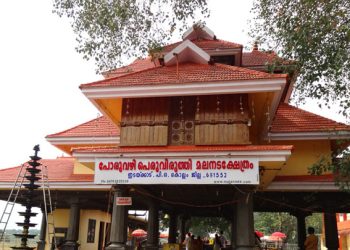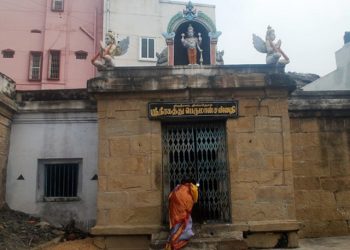The form of Lord Ranchhodrai is that of the Lord Vishnu with four arms. As is usual with Lord Vishnu, he bears the conch, lotus, discus and the mace in his hands. The lower right arm is held up in the Abhaya mudra – giving protection to all those who come to Him.
Shrine’s History
Dakor, in its earlier phases as pilgrimage center in Gujarat, was famous for the Danknath temple, a place of shiva worship. In the later phases it developed into a Vaishnavite center with the growing fame of Ranchhodraiji [form of Lord Shri Krishna] temple, which was built in 1772 A.D. Today this place is known not only as a pilgrimage center but also a trading center where one can get the articles related to puja, and other rituals. Recently, Dakor is included in one of the six major pilgrimage places under “Yatradham Vikas Board” by Government of Gujarat for development as a well-planned and well-organised pilgrimage place to facilitate the lacs and lacs of visiting pilgrims. More than 70?80 lacs of pilgrims visit the place every year and a continuous increase is witnessed every year.

Architectural Relevance of This Shrine
The present temple was constructed by Shri Gopalrao Jagannath Tambwekar in 1772 A.D. at the cost of rupees one lakh. It was built with brick walls and stones pillars. It is raised on a high plinth of 168 feet by 151 feet with twelve stone steps on each side and surrounded by a spacious courtyard. It has eight domes and twenty-four turrets, the highest of them being 90 feet making it the tallest temple in the district. The main gate of the temple overlooks the banks of the lake Gomati. Silver gates are protected by the Vedic Gods – Lord Ganesha, Sun, Moon, etc. beautifully carved in high relief. The gate leads into the main courtyard. As tradition would have it, drummers sit atop the main gate on a balcony of their own. The “Nagarkhana” resonates with music during the main darshans and at Aarti times.
On entering the courtyard, one sees two tall structures, used to house the thousands of lamps that are lit during the festive season, on either side. Multi-storied and multi-tiered, this type of structure is very typical of medieval Gujarati temple architecture. Back at the front gate, marble stairs lead to the main audience chamber of the temple – the Jagmohan – literally the place where the world is charmed . Three large entrances allow devotes to enter the main audience chamber. The large open square structure of the audience chamber is surmounted by an imposing, glittering dome. Till recently, the dome was painted with Shri Krishna’s rasa-lila in the classical Bundi style. Recently, this has been replaced by an intricate inlay of mirror work, depicting flowers and trellis in a classical Rajput garden.
Painted murals from Lord Krishna’s life adorn the walls of the audience chamber. A small section at the front of the chamber is railed off and reserved for women. As with all classical temples, the inner sanctum of Ranchodrai is set in a straight line from the main gate of the temple. The Lord sits under a canopied pavilion in the inner sanctum. The whole structure is raised on a marble platform and the pillars of the pavilion are covered in gold. The intricately carved doors and windows to the inner sanctum are covered in silver. There are three doors leading into the inner sanctum. The door to the right of the Lord comes in from the antechamber, leading to a special bathroom where the priests must bathe before entering the inner sanctum. Corridors from here, also lead to the treasure house of the Lord – housing His in-numerable jewels and clothes. The door in front of the Lord faces the main audience chamber. At Dakor, the Lord spends as much time as possible with His devotees. The main doors to the inner sanctum are open most of the day. The doors only close when the Lord sleeps – during the afternoon and at night. The door to the left of the Lord leads to the bedchamber of the Lord – a mirrored chamber of thousand delights.
Various beds, mattresses and blankets are neatly arranged in here for the Lord’s comfort. Silver and gold bedsteads are covered in soft cotton and silks. Perfumes and garlands are kept in readiness for the Lord. A small corridor leads from here to the open hall behind the bedchamber, where pilgrims perform various religious rituals to please the Lord. As at Badrinathji in the Himalayas and Tirupati Balaji in South India, at Dakor, the temple of Goddess Lakshmi, wife of the Lord, is situated outside the main temple. Lakshmiji’s temple is situated in a residential part of town at a little distance from the main temple. It is believed that the Lord visits His wife on every Friday – on Fridays a courtly procession winds its way from the main temple down the lanes and bylanes of Dakor to unite the couple.
Shrine’s Map Location and How to Go There
By Road
The State Transport Bus services connect Dakor with Nadiad, Ahmedabad, Kapadwanj, Baroda, Anand, Sevalia, Godhra, Indore, Dwarika, Rajkot, Junagadh, Surenderanagar, Ujjain, Ambaji, Shamlaji, Bombay etc.
By Rail
It is on Anand Godhra broad-gauge railway line and connected to Nadiad and Godhra by a state highway.
By Air
The nearest airport is Ahmedabad.
Shrine Timings
6:45 AM to 7:30 PM
Events Celebrated at This Shrine
On full moon days, people visit the temple to seek the blessings as was done by the devotee who brought Shree Krishna to the temple. So there is a great inflow of people and the town is very crowded. There is a carnival or fair taking place around February and March, on the day of the festival of Holi and observed by all Hindus as a mark for the triumph of the truth and goodness. Many people from surrounding cities come and visit the temple during these festivals, some from even far away. Sarad Purnima, which comes after the end of Navratri, is the day believed on which lord Krishna came to Dakor as ranchodrai with his great devotee known as Bodana. Lord come to Dakor to fulfil the promise that he will come to Dakor with Bodana. Sharad Purnima Krishna Janmotsav , then Second Day of Janmashtami Holi Rathyatra Diwali Bestu Varsh After New year Annakut Mahotsav Every Friday Ranchhod Ray J went at Laxmiji Temple Amali Ekadasi Tulsi Vivah Dashera Hindoda Gopalnathji Navkavihar













































